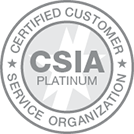Challenging Traditional Membership Concepts for Associations
The Innovation Series—inspired by Leadership Forum, AH’s exclusive client-only event—seeks to uncover the biggest, best “what’s next” ideas for associations.
 2020 has been a trying year for associations, upending traditional revenue models as events are canceled and membership budgets decrease. However, membership concerns topped association leaders’ priority lists well before that: a 2019 study by GrowthZone, reported that 57% of more than 500 association professionals surveyed cited member engagement, recruitment, and retention as their top challenge for the year. These challenges demand that association leaders think more critically about their programs and services, their appeal to members, and whether now is the time to implement significant change.
2020 has been a trying year for associations, upending traditional revenue models as events are canceled and membership budgets decrease. However, membership concerns topped association leaders’ priority lists well before that: a 2019 study by GrowthZone, reported that 57% of more than 500 association professionals surveyed cited member engagement, recruitment, and retention as their top challenge for the year. These challenges demand that association leaders think more critically about their programs and services, their appeal to members, and whether now is the time to implement significant change.
At AH’s 2019 Leadership Forum, speaker Michael Dominguez, ASAE board member and president and CEO of Associated Luxury Hotels International, a member-based organization of prestigious hospitality and travel brands, addressed association leaders’ fears head-on. “Forty percent of associations will not be relevant in five years,” Dominguez said. Associations should be empowered by that statistic to open their minds to new membership models. “There’s a critical revenue line in most associations that comes from membership dues, so it’s scary to look at that and say, ‘I’m going to do this differently.’ But remember, disruption is coming. You need to be thinking about how you’ll change in the future.”
In a year of change, now might be the right time to consider some innovative approaches to membership.
Outside Inspiration
In a year when associations have significantly changed their approach to delivering education, events, and networking, members’ loyalty is wavering: a survey by Rockbridge found that 63% of association members have engaged in education, networking, advocacy, and certification activities — traditionally associations’ territory — conducted by a for-profit organization as opposed to an association. The same survey reports that more than half of association members feel that a for-profit provider meets their networking needs better than or equally as well as an association.
Looking at the membership models and innovations in organizations other than associations can provide inspiration for unique takes on membership. One such example: Patreon, a membership platform for artists and creators and their fanbases that is making membership affordable for anyone who wants to be part of its community.
While the core of Patreon’s model is to allow patrons to directly pay and support their favorite creators, an essential — and novel — byproduct of that interaction is the conversion from unpaid consumer of content to paying member via a tiered pricing structure.
Patreon’s tiered pricing is strategically marketed to users who fit different categories; lower-priced tiers may be marketed to students while higher-priced tiers may be marketed to industry executives and super-users who have previously paid for content.
Another example of rethinking traditional memberships can be found at the Minneapolis Institute of Art (MIA), which turned the idea of membership renewals upside down with its free basic memberships that never expire. Basic membership includes a pared-down slate of benefits, like insider notifications, a subscription to the newsletter, and advance notice on sales and promotions, while paid memberships come with more traditional perks like discounted admissions, guest passes, and access to members-only events.
Redefining Members
The Patreon and MIA examples address a critical point most associations miss entirely: that membership can no longer be entirely defined by whether someone pays dues. Lowell Aplebaum, CAE, CPF, CEO of Vista Cova, spoke at AH’s 2019 Leadership Forum about the need for associations to change the way they engage and think about users who don’t pay for membership but interact with the organization on free platforms.
“The only thing separating them is dues,” said Aplebaum. “They aren’t seen as members but they’re on social media platforms like LinkedIn and Facebook engaging with an association or its members. How are they not a member of your community?”
According to Aplebaum — and Patreon and MIA — they are members regardless of whether or how much they pay in dues. A tiered pricing model creates a pathway to paid membership that might start small but can grow as members discover everything the organization has to offer.
Many associations already offer lower-cost membership options for students and early career members, while others offer various combinations of benefits available at a select subscription rate. If your association offers one of these tiered options, engage in a targeted marketing campaign to reach prospects engaging on social media as well as those who fit the audiences who might sign up for one of these different options. The goal, says Apelbaum, isn’t just to get a membership — which might be a hasty transaction and terminate after just one year. It’s to start building a relationship with your association’s community, one step at a time, developing loyalty that translates into a years-long paid membership.
Value vs Participation
Associations are founded on the concept that you must pay to see behind the wall — to have a chance to discover all the content, thought leadership, networking, and more that the organization has to offer. That, says Dominguez, is a fatal flaw.
Dominguez believes that consumer life drives consumer — and member — expectations in everything else. “The consumer world has trained a generation that there is no cost of entry,” Dominguez said. “How does that affect how your members and prospects think? It becomes, ‘I’ll pay for value, but I’m not going to pay to participate.’ This is a generational, behavioral shift.”
It’s that idea of understanding the consumer mindset and emphasis on paying for value, not for participation, that will change the way associations structure memberships.
In the example of Patreon, members may pay more for a higher-tier membership, providing them access to more content by different creators. At MIA, members with the free basic membership may upgrade to a paid membership to have access to more lucrative perks. In both instances, the organizations are giving members a chance to participate, engage, and experience what they have to offer before requiring a more significant investment; they’re demonstrating their value early on in the relationship and building on that value over time.
A Critical Look at Value
A recent study by Wiley on scientific membership societies found that the number of members belonging to more than one society or association in the same field has increased consistently for the past two years. This interesting trend challenges the notion that members are loyal to one association; in fact, members join multiple associations for different reasons. Differentiation and a focus on what an association is and is not for its members is vital to earning those membership dollars.
That differentiation starts with a clear value proposition and being able to demonstrate exactly what value members get in exchange for their membership dues. “The perception of membership value has changed,” Apelbaum said. “Value propositions are often a long list of benefits, and it’s up to the individual to find what’s right for them.”
Rather than the long, one-size-fits-all list of member benefits, associations need to revamp their member acquisition process to address the unique needs of different membership segments. “Different segments do not have the same needs, problems, or perspectives,” said Apelbaum. “Solutions and experiences need to be tailored to those challenges.” Creating more customized content and experiences for different audience segments increases engagement in everything from event registrations to volunteering and member retention.
Customized content may come in the form of a dedicated email workflow for new members, walking them through the benefits most relevant to their audience segment, or as educational content that highlights action items tailored to their career level.
As an increasing number of members join multiple associations in the same field, customized content helps further define the value of membership — especially as membership models change to welcome new facets of membership.
Membership 2.0
Changing needs and member behaviors present an opportunity for associations to engage differently by engaging non-paying members, lowering the cost of entry for new members, and customizing content and communication to establish relationships and drive value in belonging. However, the choices are endless for creative leaders ready to make a significant change.
Sign up to receive the AH Advance, AH's monthly eNewsletter, and get access to content like the Innovation Series.




